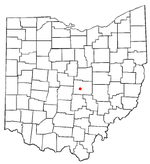Granville Female College
1827 establishments in Ohio1898 disestablishments in OhioDefunct private universities and colleges in OhioEducation in Licking County, OhioEducational institutions disestablished in 1898 ... and 3 more
Educational institutions established in 1827Former women's universities and colleges in the United StatesHistory of women in Ohio
The Granville Female College was an American women's college located in Granville, Ohio. It was established as the Granville Academy in 1827, changed its name in 1867, and closed in 1898.
Excerpt from the Wikipedia article Granville Female College (License: CC BY-SA 3.0, Authors).Granville Female College
East Broadway, Granville Township
Geographical coordinates (GPS) Address Nearby Places Show on map
Geographical coordinates (GPS)
| Latitude | Longitude |
|---|---|
| N 40.068055555556 ° | E -82.516111111111 ° |
Address
Granville Inn
East Broadway 314
43023 Granville Township
Ohio, United States
Open on Google Maps







